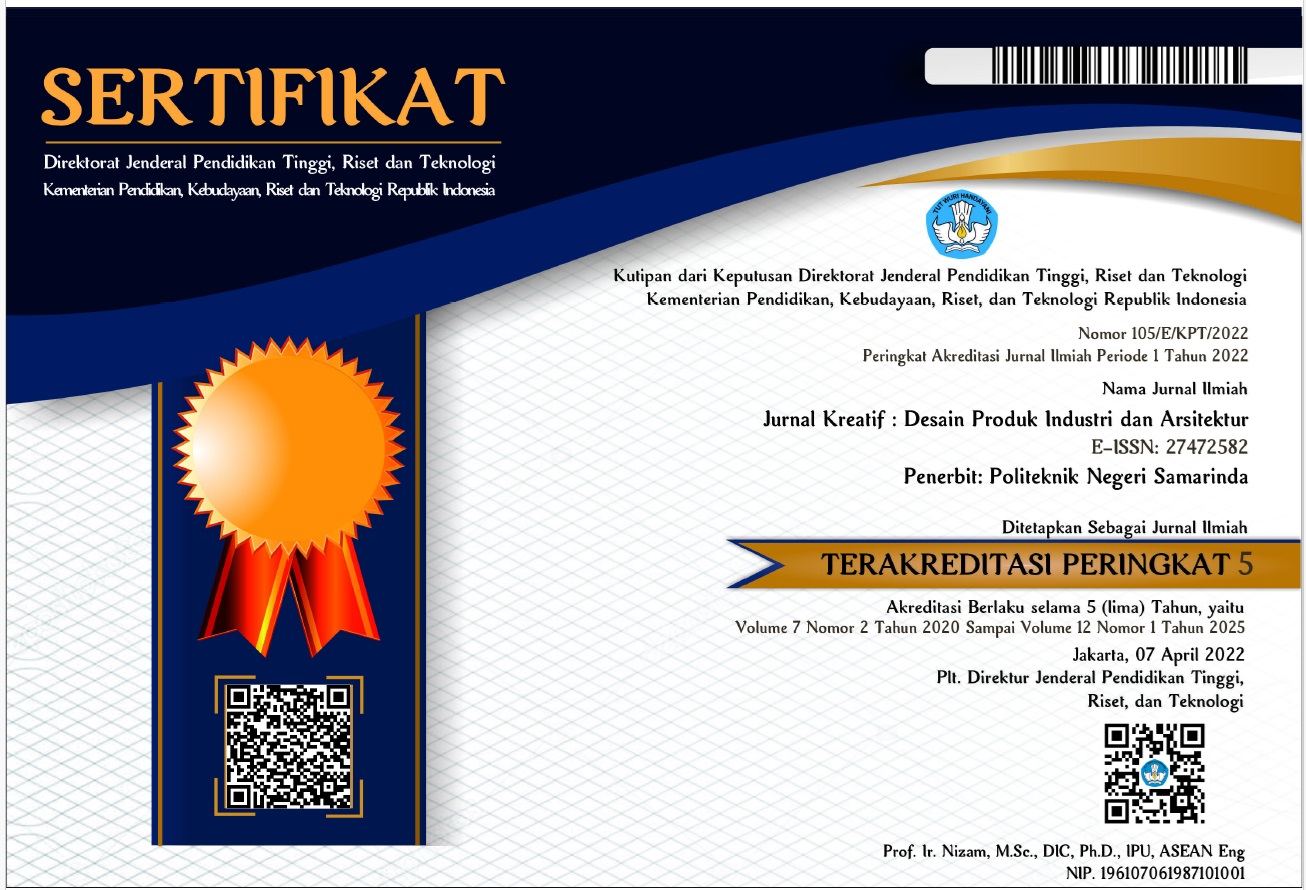ASPEK VISCERAL DAN BEHAVIORAL PADA KAIN TENUN SUTERA
 Abstract views: 269
,
Abstract views: 269
,
 pdf downloads: 230
pdf downloads: 230
Abstract
ABSTRAK
Pemberdayaan IKM merupakan salah satu dari 10 prioritas nasional dalam inisiatif making Indonesia 4.0. IKM tekstil tradisional tersebar di hampir seluruh wilayah nusantara, termasuk di wilayah Garut, Jawa Barat sebagai salah satu penghasil kain tenun sutera. Sebagai sebuah benda desain kain tenun yang dibuat harus sesuai dengan kriteria yang diharapkan oleh pengguna. Penelitian ini diharapkan mampu bermanfaat bagi IKM tekstil tradisional untuk mengidentifikasi karakteristik kain tenun dilihat dari interaksi manusia dan desain pada tahapan visceral dan behavioral, sehingga produk yang dihasilkan sesuai dengan kebutuhan penggunanya. Interaksi pada tahap visceral dapat diukur melalui evaluasi sensori terhadap sifat taktil dengan indera peraba dan tampilan visual kain tenun dengan indera penglihatan, bahkan sifat taktil dan tampilan visual menjadi preferensi pilihan yang penting bagi pengguna saat memilih kain tenun. Sedangkan respon yang muncul setelah penggunaan dalam selang waktu tertentu merupakan bentuk interaksi pada tingkat behavioral. Pengujian data hasil eksperimen dengan Anova satu arah terhadap empat sampel kain tenun sutera Garut yang memiliki perbedaan struktur anyaman menunjukkan bahwa kain tenun dengan anyaman polos dinilai memiliki sifat taktil yang paling baik dan diperkirakan paling nyaman jika dipergunakan sebagai benda pakai. Begitu pula dengan perbedaan tampilan visual kain yang disebabkan oleh aplikasi teknik desain permukaan menjadi preferensi yang penting bagi pengguna saat memilih kain tenun. Lebih lanjut, pengujian korelasi Pearson membuktikan bahwa preferensi pilihan yang diakibatkan oleh sifat taktil dan tampilan visual kain tenun tidak berpengaruh terhadap munculnya bentuk interaksi pada tingkatan behavioral; terkait dengan fungsi, cara penggunaan serta tingkat kenyamanan bagi penggunanya.
Kata kunci : behavioral, evaluasi sensori interaksi manusia dan desain, visceral
ABSTRACT
Small and Medium Enterprises (SME) empowerment is one of 10 national priorities in making Indonesia's 4.0 initiative. Traditional textile SME spreads in almost all regions of Indonesia, including in Garut, West Java as a producer of silk woven. As a design object, woven fabric must be in accordance with the expected criteria by the user. This research is expected to be useful for traditional textile SMEs to identify the characteristics of woven fabric seen from human and design interaction at the visceral and behavioral level, so that the products are in accordance with user requirements. The sensory evaluation of tactile properties of woven fabric by touching and visual appearance assesment are forms of human interaction and design on the visceral level. In fact, both are become main preferences to the user when deciding to buy woven fabrics. While the response that appears after being used in a certain time interval is a form of interaction at the behavioral level. Tactile properties and visual appearance of the woven fabric which can be evaluated subjectively by human senses is a form of human interaction with the design on a visceral level. Analysis of one way anova against four types of woven silk with diffrent structure shows that as textile materials, plain fabrics rated as the best in total handling properties and considered as the most convenient when used as wearable items. According to it’s visual appearance, the type of surface design on fabric be important to the user preferences when choosing fabrics. Pearson correlation testing showed that the preferences of the user's choice posed by the visceral aspect due to the tactile properties of woven fabric and surface design applications had no effect on the appearance of interaction at the level of behavioral aspects associated with the function, useability and the physical responses.Keywords : behavioral, sensory evaluation, visceral
Downloads
References
Brand, RH. (1964) Measurement of Fabric Aesthetic, Textile Research Journal
Kanai, Hiroyuki (2011) : Identification of Principal Factors of Fabric Aesthetics by The Evaluation From Experts on textiles and From Untrained Consumers, Textile Research Journal
Norman, D. A. (2004). Emotional design: Why we love (or hate) everyday things. Basic books.
Pan, N. (2006). Quantification and evaluation of human tactile sense towards fabrics. International Journal of Design & Nature, 1, 1–13
Philippe, F., Schacher, L.. Adoplphe, D.C. and Dacremant, C. (2004), Tactile Feeling : Sensory Analysis Applied to Textile Goods. Textile Res, J. 74 (12), 1066-1072
Winakor, Greitel and Charles J, Kim (1980), Fabric Hand : Tactile Sensory Assesment, Textile Research Journal
Authors who publish with this journal agree to the following terms:
- Copyright on any article is retained by the author(s).
- The author grants the journal, right of first publication with the work simultaneously licensed under a Creative Commons Attribution License that allows others to share the work with an acknowledgment of the work’s authorship and initial publication in this journal.
- Authors are able to enter into separate, additional contractual arrangements for the non-exclusive distribution of the journal’s published version of the work (e.g., post it to an institutional repository or publish it in a book), with an acknowledgment of its initial publication in this journal.
- Authors are permitted and encouraged to post their work online (e.g., in institutional repositories or on their website) prior to and during the submission process, as it can lead to productive exchanges, as well as earlier and greater citation of published work.
- The article and any associated published material is distributed under the Creative Commons Attribution-ShareAlike 4.0 International License













